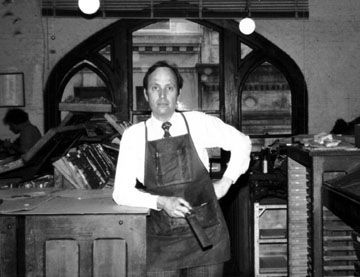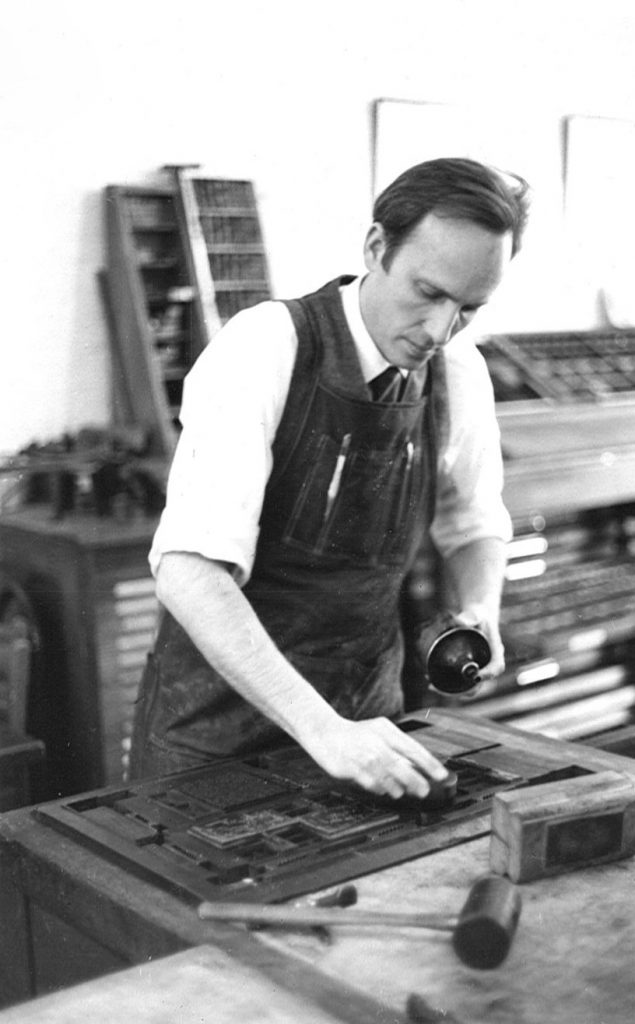By JEROME TARSHIS
The announcement from Arion Press arrived on the Friday before Thanksgiving: Andrew Hoyem, the company’s founder and one of the most distinguished fine printers in the world, had retired. So had his wife, Diana Ketcham, Arion’s editorial director.
Arion, located in the Presidio, is reported to be up for sale. Pending further developments, the existing staff of 10 will carry on the business.
The last book Arion published before Hoyem’s retirement, Exit Ghost, a novel by Philip Roth with illustrations by R. B. Kitaj, is itself valedictory; it suggests that sooner or later it is time to say goodbye. Exit Ghost is the last of nine novels featuring the controversial Jewish writer Nathan Zuckerman, widely thought to be Roth’s alter ego. Roth, who announced his retirement from fiction writing in 2012, lived long enough to authorize the publication of Exit Ghost. But he died in May of this year, before he could see printed pages.
Hoyem and Ketcham are, happily, still alive and in good health. Hoyem’s retirement was long anticipated; he had been a printer in San Francisco for more than 50 years. From relatively modest beginnings, Arion grew to be America’s — and arguably the world’s — pre-eminent publisher of fine limited editions.
Its sumptuous edition of Moby-Dick and its folio Bible, probably the last Bible to be printed from metal type, may be considered Arion’s largest efforts. But the company hasn’t disdained the popular: It has also reprinted Dashiell Hammett’s The Maltese Falcon, with archival photographs of San Francisco in the 1920s, paired with a newer look at the same locations by photographer Edmund Shea.
Although not all Arion books are set entirely by hand and printed by letterpress, the kind of publishing Arion does ultimately depends on metal type, increasingly hard to come by in the age of digital typesetting and offset printing. In 1989, Arion bought Mackenzie & Harris, America’s oldest and largest surviving type foundry, with origins dating back to the Panama-Pacific International Exposition of 1915. The foundry still sells type to letterpress printers all over the world.
Arion is not only a business. Together with its type foundry, it has become a living museum of printing history and a school for young printers. In October 2000, Hoyem created the Grabhorn Institute, an umbrella nonprofit meant to preserve and expand his integrated printing and publishing operation. With his retirement he leaves behind an enterprise designed to have a hopeful future as well as a celebrated past.
VIDEO: Anthony Bourdain at Arion Press
It all started in a former shoe repair shop
Since 2001 Arion Press and its joint enterprise, M & H Type, have occupied a spacious building at 1802 Hays Street in the Presidio. But things weren’t always so spacious: Andrew Hoyem’s beginnings as a printer took place in painfully modest premises in the Western Addition.
Hoyem is a poet and visual artist, and like many another young American in the early 1960s, he was aware that exciting things in literature, art and music were happening here. After graduating from Pomona College in 1957, he became a naval officer for three years, and planned to enroll as a graduate student at Columbia University in New York in the fall of 1961. But he had an errand in San Francisco.
He had submitted a book of poems by his friend Paul Reps to the Auerhahn Press, a small publisher with an emphasis on good graphic design and fine printing that appealed to the artist in him. Auerhahn accepted the book, but nothing more had happened. Hoping to nudge along the publication, Hoyem went to Auerhahn’s office and printing plant, then in a former shoe repair shop at 1334 Franklin Street, near Sutter.
He found a disorganized business. The entire staff was Dave Haselwood, himself a poet, who had come here from Wichita, Kansas, with his high school and college friend Michael McClure. Seeing a need he might be able to fill, Hoyem offered to work in the printing shop in exchange for room and board. It was meant to be a temporary arrangement, but Hoyem found himself more and more interested in printing and by summer had become a partner.
He had no background in publishing or printing, and Haselwood had only taken a printing shop course in high school. “We learned from our mistakes,” Hoyem remembers. It turned out there was a better way.
At 1335 Sutter, around the corner from Auerhahn, was Grabhorn Press, then San Francisco’s leading fine printer. Facing a particularly desperate problem, Hoyem plucked up courage and asked Ed and Bob Grabhorn for help.
They sent one of their printers, Sherwood Grover, back to Auerhahn with him. Grover solved the problem and added the homely advice that a recalcitrant printing press will often do the right thing if you kick it.
Hoyem stayed in touch, and before long he was working part time at Grabhorn. When Grabhorn offered him a full-time job, it made sense to dissolve the Auerhahn partnership.
In 1964, Hoyem left Grabhorn to go into business as Andrew Hoyem, Printer. Two years later, after the Grabhorn brothers had wound up their business, Hoyem formed a partnership, Grabhorn Hoyem, with Bob Grabhorn and his wife, Jane. They died in 1973, and Hoyem renamed the firm after the legendary Greek poet Arion. The rest is history.
— Jerome Tarshis






